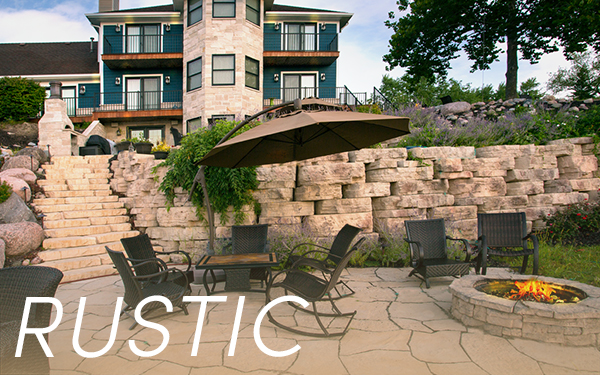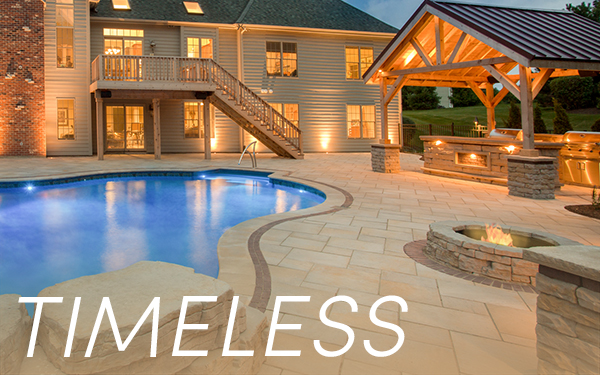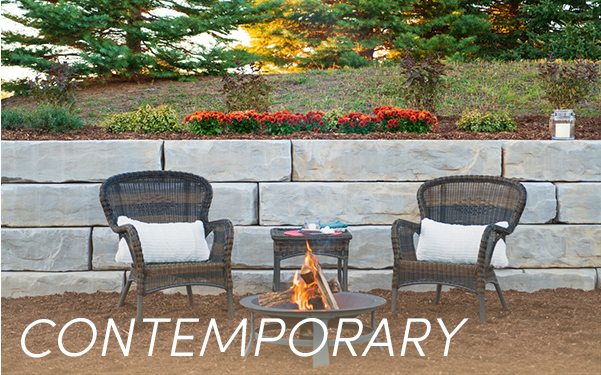Which Material Should I Choose for My Patio? Decking, Pavers, or Stone?
Avg. Read Time: 3 min, 21 sec
From pavers and decking to stone and concrete, each outdoor living space material offers unique benefits depending on your design goals, site conditions, and long-term expectations. This guide compares the most common patio materials based on installation cost, maintenance, durability, and design versatility so you can make a confident, informed choice for your patio design.
Hardscape Highlights
Short on time? Here are this article’s key takeaways…
Choose materials based on your project’s purpose, aesthetic preferences, and maintenance tolerance.
Wet cast pavers and slabs offer premium appearance and patio durability for high-traffic spaces.
Composite decking is great for raised patios or low-maintenance homeowners.
Porcelain, stamped concrete, and dry cast pavers suit a range of budgets and design styles. Always consider how your local climate, terrain, and intended usage should influence your material selection.
Patio Materials: Pros & Cons
Here’s how today’s most popular patio materials stack up for real-life outdoor spaces:
Wet Cast Pavers and Slabs (Rosetta Hardscapes)
Best for: Premium patios, projects within freeze-thaw zones, coordinating with outdoor kitchens, fire features, and garden and retaining walls
Why choose them: Wet cast concrete pavers offer a refined, natural-stone appearance and are engineered for strength and long-term performance. They’re ideal for high-traffic areas and upscale spaces that may include additional features such as outdoor kitchens and firepits, where durability and aesthetics are top priorities.
Why avoid them: Can be more expensive upfront, though not as pricey as natural stone.
Installation & Maintenance: Designed to be installed quickly and efficiently with small crews. Easy to maintain with occasional sealing.
Dry Cast Pavers
Best for: Budget-conscious hardscapes that aim to keep patio costs in check, and for areas with moderate wear expectations
Why choose them: Dry cast pavers are an affordable option available in various colors and patterns. They work well for walkways and patios.
Why avoid them: Dry cast lacks the textural depth of wet cast options. Dry cast patios may see shortened lifespans in regions experiencing frequent freeze-thaw cycles.
Installation & Maintenance: Typically easy and cost-effective to install. May require periodic maintenance to prevent fading or weed growth between joints.
Natural Stone
Best for: Classic patios, gardens, and rustic landscapes
Why choose them: Natural stone like bluestone, flagstone, or limestone offers unmatched organic beauty and character. It’s a timeless option for those seeking a high-end, one-of-a-kind aesthetic appeal for their patio.
Why avoid them: Since each piece is custom-fit, installation takes more time and is more expensive. Finding enough consistently colored stone can be challenging for larger projects.
Installation & Maintenance: Installation requires an experienced contractor. Can stain more easily than concrete and may need sealing or specialized cleaning.
Stamped Concrete
Best for: Large patios with decorative finishes
Why choose it: Stamped concrete can somewhat mimic the look of stone or tile at a lower material cost. It’s considered a more affordable, poured concrete patio option, ideal for large areas where a seamless look is desired.
Why avoid it: Lacks the high-end texture of alternatives like natural stone or wet cast. Prone to cracking over time, especially in freeze-thaw zones. Can be slick when wet, and may require additional texturization or sealers to enhance slip resistance.
Installation & Maintenance: Requires professional installation and sealing to preserve color and pattern.
Your Dream Patio Starts with the Right Questions
When it comes to realizing your vision and getting the patio of your dreams, know what to ask and when to ask it with our 10 Questions You Didn’t Know You Should Ask Your Hardscape Contractor guide.
Porcelain Pavers
Best for: Sleek, modern patios or rooftops
Why choose them: Porcelain pavers offer a clean, contemporary look with low water absorption and excellent fade resistance. A popular choice for climates with temperature swings.
Why avoid them: A premium material with the pricetag to prove it. While reasonably durable, its thin composition can result in shattering if impacted. Can be slippery when wet.
Installation & Maintenance: Base layer construction must be exact to ensure porcelain pavers are balanced and don’t shatter if stressed. Easy to clean with no sealing required.
Brick
Best for: Traditional landscapes, historic homes, or cottage gardens
Why choose them: Brick delivers old-world charm and a sense of warmth. It's especially fitting for homes with brick architecture or colonial-style details and smaller patio or walkway areas.
Why avoid them: Typically available in basic colors and shapes which limits design versatility. High porosity can lead to easy staining, mildew, or moss growth, and cracking or spalling from repeated freeze-thaw cycles.
Installation & Maintenance: Requires more cutting and alignment, which can drive up installation time and costs. Regular upkeep (especially in damp or shady areas) is required. Prone to shifting or settling over time.
Wood Decking
Best for: Elevated patios or projects requiring a softer, warmer feel
Why choose it: Wood offers a typically affordable classic look and can be stained to match any aesthetic. Best for elevated spaces, tiered landscapes, or areas with poor drainage.
Why avoid it: Even pressure-treated lumber has a shorter lifespan (15-25 years) than most alternatives. Higher maintenance product that needs regular attention to keep looking good. Can become slick when wet.
Installation & Maintenance: Straightforward installation often requiring a substructure. Requires regular power washing and staining or sealing to prevent rot, warping, and insect damage.
Composite Decking
Best for: Low-maintenance, elevated outdoor living
Why choose it: Composite materials mimic the look of wood without the upkeep. They resist moisture, insects, and fading, making them ideal for homeowners who want the natural look of wood and a worry-free patio.
Why avoid it: Composite decking materials often cost significantly more than wood and some paver options. Despite recent improvements, many brands still struggle to mimic the deep textures and authenticity of real wood. Composite decking also retains heat at a higher rate, and can become uncomfortably hot to walk on, especially in darker colors.
Installation & Maintenance: Construction of a substructure is typically needed. Higher upfront material cost but minimal maintenance. Works best in clean, contemporary outdoor designs.
Site Scenarios That Should Influence Material Choice
In addition to your personal style preference and budget, special considerations should help guide your material choice. Here are a few circumstances that lend themselves to specific material choices:
- Shady, damp yard? Avoid porous materials like brick or untreated wood. Opt for porcelain, wet cast, or composite decking instead.
- Entertaining frequently? Wet cast pavers or stamped concrete provide solid, consistent surfaces for seating and grilling areas.
- Uneven or sloped site? Wood or composite decking can adapt easily to elevation changes, as can solutions that pair with retaining walls like Rosetta Hardscapes.
- Historic home or cottage aesthetic? Brick and natural stone blend beautifully with classic architectural styles.
- Modern rooftop or balcony? Lightweight porcelain pavers on pedestals offer style without the structural load.
The Bottom Line
The best patio material isn’t just about looks, it’s about finding the right fit for your lifestyle, space, and goals. Whether you dream of a rustic stone courtyard, a sleek composite deck, or a showstopping outdoor kitchen with wet cast pavers, your choice matters. Think long-term, evaluate your site, and don’t hesitate to ask your contractor for guidance. With the right materials and support, your patio can be a place of joy and connection for years to come.

Contributing Expert
Hardscape Nate
It's not his legal name, but "hardscape" is this guy’s way of life. Hardscape Nate Fuelleman has spent 20+ years helping families get the most out of their backyards and landscape contractors level up their outdoor living installation businesses. He geeks out over garden walls, pavers, steps, and fire features. And why wouldn’t he? A thoughtfully designed and expertly crafted outdoor space can forge friendships, make memories, and heal the soul. Think he’s overselling it? Spend a summer evening on the patio enjoying an oaky Chardonnay or a gooey s'more while listening to the crackle of a flickering fire. You can thank him later.


